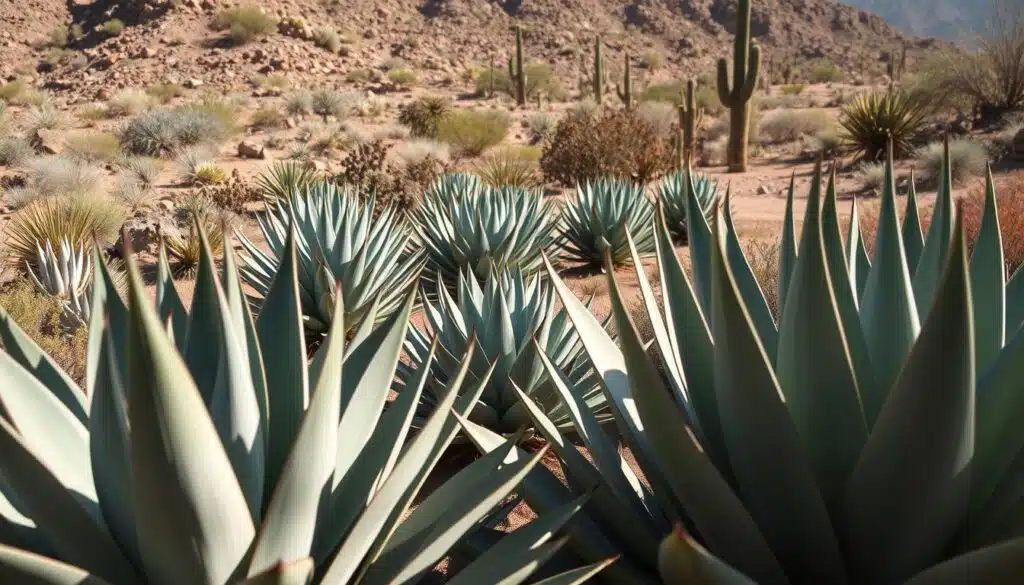Imagine walking through the arid landscapes of Southern California or Arizona, where the desert agave stands out as a symbol of resilience. This succulent, also known as Agave deserti, is a striking plant with its rosette of gray-green leaves and sharp spines. Native to the Sonoran Desert and Baja California, it thrives in rocky slopes and dry soils, making it perfect for waterwise gardens.
What makes the desert agave special? It’s incredibly drought-tolerant and grows slowly, forming a dramatic tall stalk covered in yellow flowers when mature. While individual plants die after blooming, the colony continues to grow, ensuring its longevity. This plant isn’t just beautiful; it’s also tough, enduring extreme conditions with ease.
If you’re thinking of adding it to your garden, remember those sharp spines. Plant it away from walkways to avoid any accidents. Whether you’re in Southern California or another dry region, the desert agave is a great choice for a low-maintenance, stunning addition to your landscape.
Exploring the Desert Agave: Unique Characteristics and Natural Habitat
The desert agave is a true marvel of nature, known for its striking appearance and adaptability to harsh environments. This succulent, scientifically referred to as *Agave deserti*, boasts a distinctive rosette formation with long, gray-green leaves that are both tough and visually appealing. Each leaf is edged with sharp, protective spines, creating a unique and recognizable silhouette.
In its natural habitat, the desert agave thrives on rocky slopes and in desert washes, commonly found in Southern California, Arizona, and Baja California. These areas provide the well-draining soil and arid conditions the plant prefers. The agave’s growth habit is fascinating—it often forms clusters, yet each plant retains its individual characteristics.
When mature, the desert agave produces a tall, striking spike of yellow, funnel-shaped flowers. This inflorescence not only adds to the plant’s beauty but also attracts pollinators like hummingbirds and insects. The plant’s ability to support other species in its ecosystem, such as creosote and shadscale scrubs, highlights its importance in desert habitats.
By understanding these unique traits and environmental preferences, gardeners can better appreciate the desert agave’s resilience and beauty, making it an ideal choice for waterwise landscapes.
Cultivating Your Agave Garden in a Desert Landscape
Bringing the beauty of the desert to your garden can be a rewarding experience, especially with the striking desert agave. This section will guide you through the essential care tips and soil, water, and sunlight requirements to help you grow this stunning succulent successfully.
Essential Care Tips and Maintenance Guidelines
To ensure your desert agave thrives, consider the following tips:
- Plant in well-draining, rocky soil to mimic its natural habitat.
- Water sparingly—once a month is sufficient once established.
- Provide full sun exposure for optimal growth.
- Propagate by carefully removing pups from the mother plant.
Soil, Water, and Sunlight Requirements
| Factor | Recommendation |
|---|---|
| Soil | Well-draining, rocky soil |
| Water | Minimal irrigation (once a month) |
| Sunlight | Full sun |
By following these guidelines, you can create a thriving desert agave garden that reflects the beauty of its natural habitat.

The History, Ethnobotany, and Versatile Uses of Agave
For centuries, the agave plant has been a cornerstone of culture and survival in arid regions. Its rich history and versatility have made it a valuable resource for various uses.
Traditional Cultural Uses and Food Heritage
Native Americans relied on agave for essential needs. They used its strong fibers to craft ropes and bowstrings, while the plant’s heart was roasted for food. This made agave a vital resource during droughts.
- Used for making durable ropes and bowstrings.
- Roasted for a nutritious, sustaining food source.
- Transformed into beverages like pulque and mescal, holding cultural significance in regions like Baja California and Arizona.
Modern Landscape Design and Conservation Efforts
Today, agave is prized in garden design for its striking appearance and low water needs. Conservation efforts focus on protecting natural habitats and promoting sustainable gardening practices inspired by traditional methods.
- Incorporated into modern gardens for bold aesthetics and water efficiency.
- Conservation projects aim to preserve agave populations and their habitats.
- Historical cultivation practices inform current sustainable gardening techniques.
From ancient uses to modern applications, the agave continues to be a symbol of resilience and utility, bridging the past with present-day values in landscape design and environmental conservation.
Closing Reflections on Embracing the Agave Lifestyle
Reflecting on my journey with the desert agave, I find myself captivated by its resilience and beauty. This succulent, known as *Agave deserti*, has not only enriched my garden but also deepened my appreciation for nature’s adaptability. Its journey from the harsh desert landscapes of Southern California and Arizona to thriving in urban gardens is truly inspiring.
What draws me to this plant is its striking appearance and minimal care requirements. The desert agave’s rosette of gray-green leaves, adorned with sharp spines, adds a dramatic touch to any landscape. Its ability to survive with minimal water makes it a perfect choice for those seeking a sustainable garden. I’ve personally found joy in nurturing this plant, watching it grow into a symbol of resilience in my own backyard.
Beyond its aesthetic appeal, the agave holds a rich cultural and historical significance. From being a vital resource for Native Americans to its modern role in eco-friendly gardening, this plant bridges the past and present. Its versatility in uses, from food to landscape design, underscores its importance in both tradition and conservation efforts.
I encourage everyone to consider adding an agave to their garden. Not only will it bring a touch of desert beauty to your space, but it will also contribute to a more sustainable future. Embrace the agave lifestyle and join a community that values resilience, beauty, and environmental stewardship. Caring for this plant is more than gardening—it’s a celebration of a timeless legacy.


